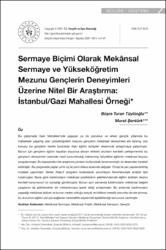| dc.contributor.author | Turan Tüylüoğlu, Büşra | |
| dc.contributor.author | Şentürk, Murat | |
| dc.date.accessioned | 2021-12-12T16:49:41Z | |
| dc.date.available | 2021-12-12T16:49:41Z | |
| dc.date.issued | 2020 | |
| dc.identifier.issn | 2147-8473 | |
| dc.identifier.uri | https://app.trdizin.gov.tr/makale/TkRVeU16WXdNQT09 | |
| dc.identifier.uri | https://hdl.handle.net/20.500.11857/2059 | |
| dc.description.abstract | Bu çalışmada Gazi Mahallesi’nde yaşayan ya da çocukluk ve erken gençlik yıllarında bumahallede yaşamış olan yükseköğretim mezunu gençlerin mekânsal deneyimleri ele alınmış, sözkonusu bu gençlerin kentle kurdukları ilişki eğitim süreçleri ekseninde anlaşılmaya çalışılmıştır.Bunun için gençlerin eğitim hayatları boyunca devam ettikleri okulların kentteki yerleşimlerinin bugençlerin deneyimleri üzerinde nasıl konumlandığı irdelenmiş, böylelikle eğitimin mekânsal boyutusorgulanmıştır. Bu kapsamda nitel araştırma yöntemi kullanılarak fenomenolojik bir desenden hareketedilmiştir. Bu çerçevede yaşları yirmi üç ile yirmi dokuz arasında değişen 13 kişi ile yarı yapılandırılmışmülakat yapılmıştır. Veriler Atlas.ti programı kullanılarak yorumlayıcı fenomenolojik analize tabitutulmuştur. Buna göre katılımcıların mekânsal pratiklerinin şekillenmesinde eğitim aldıkları okulunkentsel konumunun rol oynadığı görülmüştür. Bunun aynı zamanda katılımcıların mekânsal beğeniyargılarını da şekillendiren bir mekanizmaya işaret ettiği anlaşılmıştır. Bu anlamda katılımcılarınyaşadığı mekânsal aidiyet ve bunun neden olduğu sosyal ve kültürel mesafe sorunları da ele alınmış,bu durumun eğitim yoluyla sağlanan hareketlilik sayesinde aşılabileceği sonucuna varılmıştır. | en_US |
| dc.description.abstract | This study discusses the spatial experiences of young people who lived in Istanbul’s Gazi District during their childhood and early adolescence. We have attempted to understand the relationship that these young people have with the city through the lens of education processes. By examining how the physical location of the schools that these young individuals attended impacts their experiences in the city, we have questioned the spatial dimension of education. Due to the study’s qualitative nature, we employed a phenomenological pattern while developing a semi-structured interview form that was then executed with 13 people between the ages of twenty-three and twenty-nine. Atlas.ti was used to carry out an interpretive phenomenological analysis. The results reveal that schools’ urban location affected participants’ spatial practices, implying a mechanism that shapes participants’ spatial preferences. We also discussed problems pertaining to spatial belonging and social and cultural distance experienced by the participants. The study concludes finding that the mobility provided by education can help young individuals overcome this predicament. | en_US |
| dc.language.iso | tur | en_US |
| dc.relation.ispartof | GENÇLİK ARAŞTIRMALARI DERGİSİ | en_US |
| dc.rights | info:eu-repo/semantics/openAccess | en_US |
| dc.subject | [No Keywords] | en_US |
| dc.title | Sermaye Biçimi Olarak Mekânsal Sermaye ve Yükseköğretim Mezunu Gençlerin Deneyimleri Üzerine Nitel Bir Araştırma: İstanbul/Gazi Mahallesi Örneği | en_US |
| dc.title.alternative | A Qualitative Study on Spatial Capital as Capital Form and the Experiences of Young University Graduates: The Case of Istanbul/ Gazi | en_US |
| dc.type | article | |
| dc.department | Fakülteler, Fen-Edebiyat Fakültesi, Sosyoloji Bölümü | |
| dc.identifier.volume | 8 | en_US |
| dc.identifier.startpage | 47 | en_US |
| dc.identifier.issue | 21 | en_US |
| dc.identifier.endpage | 73 | en_US |
| dc.relation.publicationcategory | Makale - Ulusal Hakemli Dergi - Kurum Öğretim Elemanı | en_US |



















